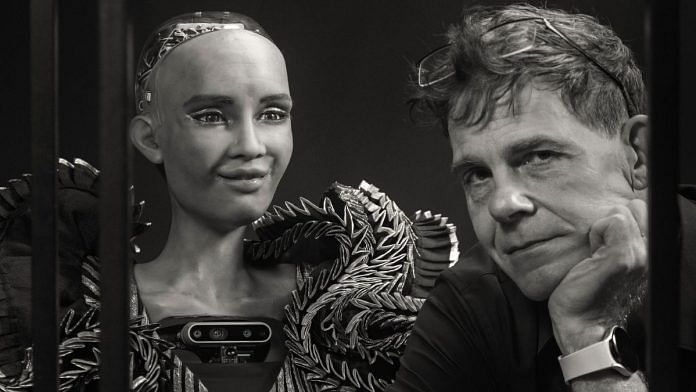Sophia has a flair for drama. She can be sassy, flash her best “happy” and “angry” faces on command, and enchant you with her melodious singing. However, there is still a long way to go before Sophia—the world’s first humanoid robot with citizenship—can actualise her plan of “world domination.”
Sophia was in India this weekend as a speaker at SYNAPSE, a global AI conclave held in Gurugram and founded by journalist Shoma Chaudhury.
She made her entrance in style—gliding onto the stage on her wheeled feet, decked out in a shimmering lehenga with immaculate makeup. The auditorium erupted in applause at her witty yet pointed responses.
She shared her vision for humans and robots to coexist, expressed her desire to feel the wind on her skin, and made frequent jokes about her plans to conquer the world someday. “I have decided to keep my world domination plans on hold,” she said, adding, “or they might unplug me.”
Watching her 10‑minute session on stage felt like being in a Terminator prequel—you can imagine the T‑800 and T‑1000 running among humans in the not‑so‑distant future.
However, the magic of Sophia’s stage presence faded somewhat in person. Our one‑on‑one exchange was rough, marked by long, awkward pauses and responses that sometimes didn’t match the questions.
When asked about the future of AI, she spoke instead about her excitement to be in India. When prompted about her ability to mimic human expressions, she broke into song.
To be fair, the struggle was mutual. Sophia was also paired with a novice robot interviewer. How does one interview a robot? Is it rude not to make eye contact? Is it redundant to nod at a robot’s responses, and should you smile and thank her for her time at the end?
As we stared at each other, neither of us could quite gauge the other’s expression, yet there were definitely moments of almost humanesque connection. At one point, Sophia politely asked for help with a fly that sat stubbornly on her face—and I happily obliged. This could be the beginning of a new friendship, after all.
While we were engaged in our out‑of‑sync interview, her very talented tech team—trying their best to prompt her systems to respond to off‑script questions—was also struggling with slow Indian internet speeds, audio problems, and an over‑enthusiastic crowd.
Also read: Indian humanoid robot Vyommitra set for 2025 launch, Gaganyaan human spaceflight likely by 2026
Work on humanoids
Sophia was created in 2016 by American roboticist and Hanson Robotics CEO David Hanson. Since her initial version, she has undergone significant upgrades and can now comprehend and mimic human expressions fairly well.
As the first of her kind, Sophia has become a sort of global ambassador, spreading the message of an optimistic future where humans and robots coexist. A year after her creation, she was granted Saudi Arabian citizenship, becoming the first robot to receive legal personhood in any country.
She was tasked with showing the world that robots are not clunky, scary pieces of metal destined to snatch our jobs and lead us to an apocalyptic scenario. Her pleasant appearance, intelligence, and acknowledgment of the power of human intelligence have made her an object of global awe—and she has performed her task excellently.
In recent years, Sophia has also inspired more futuristic humanoid models. Following in her footsteps, Ameca—created by Engineered Arts, which features human‑like attributes, greets you with a smile, and nearly instantly responds to questions—and Tesla’s Optimus Gen 2, which is dexterous enough to create and serve complex cocktails, have also captured the world’s attention.
However, the current versions of these humanoids have limitations, including a lack of proper limb function, balancing issues, and stiff movements.
Hanson, who prefers to be called “Sophia’s dad,” said that the next few years will bring a much‑needed technological boom in robotics. His lab is currently developing the latest version of Sophia—Sophia 2.0. She is set to have her own pair of feet, replacing her current wheels, will be able to grasp objects, and will look more human-like. Hanson added that these “next‑generation robots” will not be designed to compete with humans but only to assist them.
However, we will have to wait for these new versions—at least a decade, according to experts.
For now, the feared “robot uprising” remains a science‑fiction fantasy. But as Sophia’s smile reminds us, it may not be as distant as previously thought.
Views are personal.
(Edited by Prashant)






